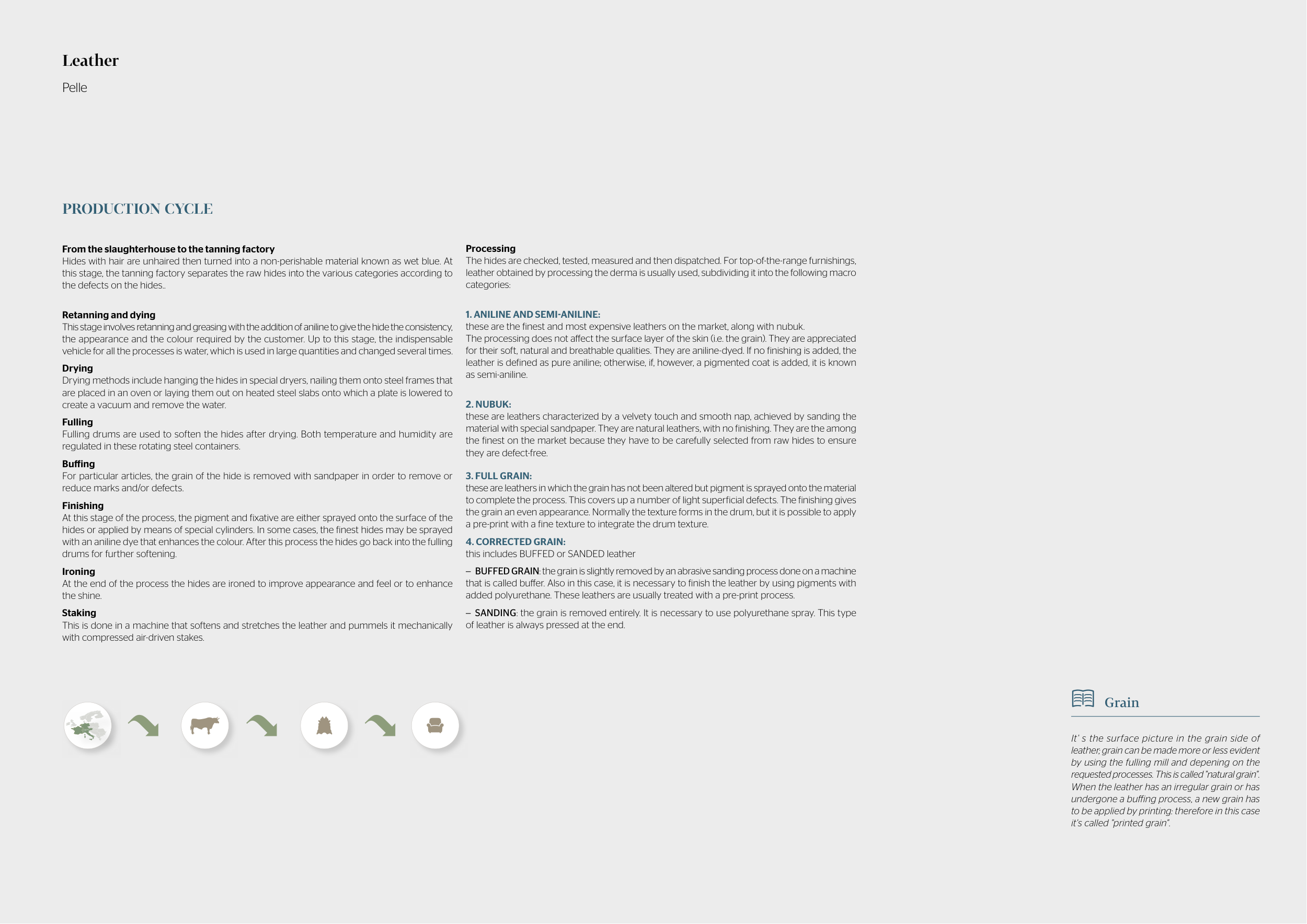23
Molteni&C Upholstery Manual
Leather
Pelle
PRODUCTION CYCLE
From the slaughterhouse to the tanning factory
Hides with hair are unhaired then turned into a non-perishable material known as wet blue. At
this stage, the tanning factory separates the raw hides into the various categories according to
the defects on the hides..
Retanning and dying
This stage involves retanning and greasing with the addition of aniline to give the hide the consistency,
the appearance and the colour required by the customer. Up to this stage, the indispensable
vehicle for all the processes is water, which is used in large quantities and changed several times.
Drying
Drying methods include hanging the hides in special dryers, nailing them onto steel frames that
are placed in an oven or laying them out on heated steel slabs onto which a plate is lowered to
create a vacuum and remove the water.
Fulling
Fulling drums are used to soften the hides after drying. Both temperature and humidity are
regulated in these rotating steel containers.
Buffing
For particular articles, the grain of the hide is removed with sandpaper in order to remove or
reduce marks and/or defects.
Finishing
At this stage of the process, the pigment and fixative are either sprayed onto the surface of the
hides or applied by means of special cylinders. In some cases, the finest hides may be sprayed
with an aniline dye that enhances the colour. After this process the hides go back into the fulling
drums for further softening.
Ironing
At the end of the process the hides are ironed to improve appearance and feel or to enhance
the shine.
Staking
This is done in a machine that softens and stretches the leather and pummels it mechanically
with compressed air-driven stakes.
Processing
The hides are checked, tested, measured and then dispatched. For top-of-the-range furnishings,
leather obtained by processing the derma is usually used, subdividing it into the following macro
categories:
1. ANILINE AND SEMI-ANILINE:
these are the finest and most expensive leathers on the market, along with nubuk.
The processing does not affect the surface layer of the skin (i.e. the grain). They are appreciated
for their soft, natural and breathable qualities. They are aniline-dyed. If no finishing is added, the
leather is defined as pure aniline; otherwise, if, however, a pigmented coat is added, it is known
as semi-aniline.
2. NUBUK:
these are leathers characterized by a velvety touch and smooth nap, achieved by sanding the
material with special sandpaper. They are natural leathers, with no finishing. They are the among
the finest on the market because they have to be carefully selected from raw hides to ensure
they are defect-free.
3. FULL GRAIN:
these are leathers in which the grain has not been altered but pigment is sprayed onto the material
to complete the process. This covers up a number of light superficial defects. The finishing gives
the grain an even appearance. Normally the texture forms in the drum, but it is possible to apply
a pre-print with a fine texture to integrate the drum texture.
4. CORRECTED GRAIN:
this includes BUFFED or SANDED leather
– BUFFED GRAIN: the grain is slightly removed by an abrasive sanding process done on a machine
that is called buffer. Also in this case, it is necessary to finish the leather by using pigments with
added polyurethane. These leathers are usually treated with a pre-print process.
– SANDING: the grain is removed entirely. It is necessary to use polyurethane spray. This type
of leather is always pressed at the end.
It' s the surface picture in the grain side of
leather; grain can be made more or less evident
by using the fulling mill and depening on the
requested processes. This is called "natural grain".
When the leather has an irregular grain or has
undergone a buffing process, a new grain has
to be applied by printing: therefore in this case
it's called "printed grain".
Grain


